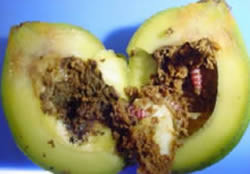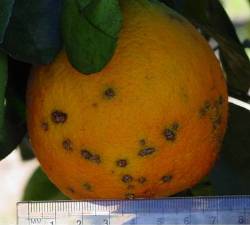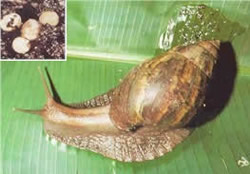Protecting Queensland from exotic pests
Emergency plant pests and diseases threaten Queensland's agriculture, environment and economy. Protecting our way of life in Queensland is everybody's business. You can help detect these pests at an early stage and reduce their impact by reporting suspicious occurrences.
Emergency plant pests and diseases may enter Queensland through several pathways. They can be spread by freight entering from overseas, tourists, interstate traveller's and even the natural movement of a pest species. Early detection is vital to increase the chances of successful eradication or containment.
Below is some practical advice on what to do if you suspect that you've seen an exotic pest.
What to look out for
It can be difficult to know what is a common pest or disease and what is an emergency plant pest or disease. Below are a few points to help you decide whether to call Biosecurity Queensland . Remember, if in doubt, call.
- Is this the first time you've noticed this pest or disease?
- Is the pest or disease causing significant damage to the plant?
- Is the damage caused by the pest unusual?
- Are you unable to find the pest in any Australian gardening or pest management book?
- Does the pest or disease resemble any exotic plant pests or diseases that you are aware of?
Who to contact
If you answered 'yes' to one or more of the above questions, contact the Biosecurity Queensland on 13 25 23 and talk to an expert.
Although Biosecurity Queensland staff are always looking out for emergency plant pests and diseases, you can help by reporting any unusual pest activity.
Penalties may apply if you fail to notify the Biosecurity Queensland of the presence of certain serious pests. If you suspect that you have found a new plant pest or disease, contact them for advice.
What information to provide
Host plant
Biosecurity Queensland's Customer Service Centre staff will need to know what kind of plant is being damaged. Provide the common name for the plant and the variety or cultivar if possible. If you know the scientific name, provide that also.
Description
You will need to provide a detailed description of the pest and the damage it is causing. Below are some questions you may need to answer:
- What sort of damage can you see on the plant(s), e.g. leaf spots, insect feeding, dieback of the plant, wilt?
- How much damage has been caused?
- Can you see what pest or disease, if any, is causing the damage?
- If so, what does the pest look like?
- Is the pest or disease present in high numbers?
What to do next
You should mark the affected plant with surveyors tape, coloured string or waterproof spray paint so that samples can be collected from the correct plant if necessary. Take a photo of the pest and damage if you can to keep a permanent record of the damage.
Do not move the pest, plant or plant parts until you have consulted with Biosecurity Queensland staff and are sure that the pest or disease is not an emergency plant pest or disease.
What the Customer Service Centre will do
The Customer Service Centre will forward your enquiry to the most appropriate staff member in Biosecurity Queensland who will determine whether you need to submit a sample or additional information. They will tell you how to collect and package the sample, and where to send it for identification.
Note: Never send live insects or plant disease specimens through the mail.
What happens if it is an emergency plant pest
If the plant pest is an important pest or disease species, Biosecurity Queensland will tell you.
It will advise national and state quarantine agencies of the detection, and a national consultative committee may be convened to decide on appropriate response measures.
Response action will depend on many factors, including the seriousness of the pest or disease and how far it has spread. If the pest poses a significant threat to agricultural systems, Australia's economy or environment, quarantine measures may be imposed.
If methods are available and the pest is isolated in a defined area, eradication or containment could be attempted. Depending on the type of pest detected, these measures could, but will not necessarily, impact significantly on the affected plant(s) you have reported.


